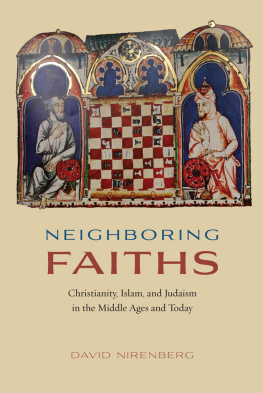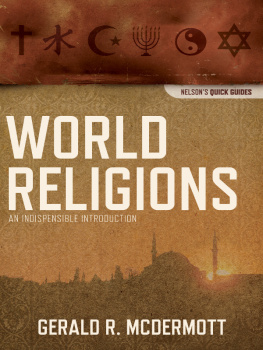DAVID NIRENBERG is the Deborah R. and Edgar D. Jannotta Professor of Medieval History and Social Thought and the Roman Family Director of the Neubauer Collegium for Culture and Society, both at the University of Chicago.
The University of Chicago Press, Chicago 60637
The University of Chicago Press, Ltd., London
2014 by The University of Chicago
All rights reserved. Published 2014.
Printed in the United States of America
23 22 21 20 19 18 17 16 15 14 1 2 3 4 5
ISBN-13: 978-0-226-16893-7 (cloth)
ISBN-13: 978-0-226-16909-5 (e-book)
DOI: 10.7208/chicago/9780226169095.001.0001
The University of Chicago Press gratefully acknowledges the generous support of the Humanities Visiting Committee at the University of Chicago toward the publication of this book.
Library of Congress Cataloging-in-Publication Data
Nirenberg, David, 1964 author.
Neighboring faiths : Christianity, Islam, and Judaism in the Middle Ages and today / David Nirenberg.
pages cm
Includes bibliographical references and index.
ISBN 978-0-226-16893-7 (cloth : alkaline paper) ISBN 978-0-226-16909-5 (e-book)
1. ReligionsRelationsHistoryTo 1500. 2. Religious adherentsHistoryTo 1500. 3. IslamRelationsChristianityHistoryTo 1500. 4. IslamRelationsJudaismHistoryTo 1500. 5. JudaismRelationsChristianityHistoryTo 1500. 6. JudaismRelationsIslamHistoryTo 1500. 7. Christianity and other religionsTo 1500. I. Title.
BL410.N57 2014
201'.50902dc23
2014004370
 This paper meets the requirements of ANSI/NISO Z39.481992 (Permanence of Paper).
This paper meets the requirements of ANSI/NISO Z39.481992 (Permanence of Paper).
Neighboring FAITHS
Christianity, Islam, and Judaism in the Middle Ages and Today
DAVID NIRENBERG
The University of Chicago Press
Chicago and London
INTRODUCTION
Neighboring Faiths
The neighbor of a Jew will never be a good Christian. The words are those of a medieval holy man, Saint Vincent Ferrer, whose massive campaign of religious segregation and conversion in the early fifteenth century forever altered the confessional landscape of Europe. They express a powerful view of the world, simultaneously sociological and theological: right faith requires distance from wrong faith, which otherwise threatens the believer.
Saint Vincent was a brilliant impresario of this viewjust how brilliant we will see in of this bookbut he certainly did not invent it. Neighboring peoples and faiths occupy a place at the heart of each of the very diverse religious traditions we call Judaism, Christianity, and Islam. The scriptures of each of these faiths contain many, sometimes quite contradictory, teachings about both the dangers and the virtues of neighborliness.
The Hebrew Bible, for example, enjoined the extirpation of the seven nations living in the Promised Land, lest their presence lead to intermarriage and idolatry (Deut. 7:15). But it also decreed the stranger that dwells with you shall be to you as one born among you, and you shall love him as yourself, for you were strangers in the land of Egypt (Lev. 19:34, Deut. 10:19). It frequently condemned certain kinds of intermarriage but did not hesitate to start the messianic line of King David with the union of a Moabite woman and a Hebrew man (on which see the Book of Ruth). And it can in one and the same prophecy envision an apocalypse in which Israels mighty and aggressive neighbors are utterly and vengefully destroyed and one in which they are saved and sanctified: Blessed be my people Egypt, Assyria my creation, and Israel my heritage (Isa. 19:25).
The New Testament, too, contains many passages that could be and have been read as commanding love of the neighbor, the stranger, and even the enemy, such as Luke 10:27, Matthew 5:43, and Hebrews 13:1. But it also preserves some that have been understood to enjoin quite the opposite. He that is not with me is against me; Do you suppose that I am here to bring peace on earth? No, I tell you, but rather division; As for my enemies who did not want me for their king, bring them here and execute them in my presence (Luke 11:23, 12:51, 19:27).
Similarly in the Quran, we can find many different injunctions about how to treat neighbors of other faiths. Some seem to encourage extermination: Fight and slay the pagans wherever you find them, and seize them, beleaguer them, lie in wait for them with every stratagem of war (Surah 9:5). Others might trend toward tolerance: It is part of the mercy of Allah that you deal gently with them [Unbelievers]. If you were severe or harsh-hearted, they would have broken away from about you: so pass over [their faults], and ask for [Allahs] forgiveness for them; and consult them in affairs (Surah 3:159).
This is not a book about the scriptures of the three religions that claim descent from Abraham. It is a book about how Muslims, Christians, and Jews lived with and thought about each other in the Middle Ages and about what that medieval past can tell us about how they do so today. But we must start with scripture, because all later periods, including our own, often look to it for instruction about the sorts of neighborliness God has in mind. It is through their reading and rereading of its pages that later Christians, Jews, and Muslims alike debated how (in the words of the greatest medieval rabbi) the Omnipresent one has sanctified us and separated us from the heathens. So it is crucial to acknowledge from the outset of our studies that the scriptures upon which all three religions are founded can themselves sustain any number of potential attitudes toward neighbors, ranging from love and toleration to total extermination.
Even this sharp distinction between love and extermination is a bit misleading: many communities of believers have read their scriptures in ways that identify
One may choose, from ones own time and perspective, to disagree with these previous interpretations of Gods will, and indeed it is important that we do so. Critical scholars of a given scripture, for example, can argue that the authors of the text could not have intended a given interpretation at the time in which it was written. Believers can cleave to the interpretations of their own particular religious community, rather than paying attention or lending credence to those of others. But as historians, at least, we have to concede that for millions of believers in other times and places, these cruel loves and sharp mercies (the phrase is Martin Luthers) could be perfectly consonant with Gods written word, even demanded by it. Among the many potential truths that scripture teaches on the subject of neighbors, the interpretations that moved these believers must count every bit as much as our own.
That concession alone can protect us from two forms of fantasy as prevalent in our age as in any other. The first is that my scripture is loving while that of the other is cruel; that my faith community is capable of tolerance and neighborliness while that of the other is not. ( will focus on a few modern manifestations of this type of fantasy.) And the second is that we have scripture right: that our interpretations have recovered its original and true intent, and that all other interpretations are misreadings whose study can provide, at best, only a history of error.
The book before you is premised on a very different conviction. It pays close attention to how Muslim, Jewish, and Christian neighbors loved, tolerated, massacred, and expelled each otherall in the name of Godin periods and places both long ago and far away. And it insists that, no matter how wrongheaded or bizarre these ways of a distant past may seem, they have something to teach us about how we think and act today. Teach not by way of example, whether positive or negative: I am not proposing that the past serve us as a model to emulate or avoid. I mean teach rather in the sense of cultivating within us a sensibility that can discover in the past a stimulus to critical awareness about the workings of our own assumptions, hopes, and habits of thought.
Next page









 This paper meets the requirements of ANSI/NISO Z39.481992 (Permanence of Paper).
This paper meets the requirements of ANSI/NISO Z39.481992 (Permanence of Paper).